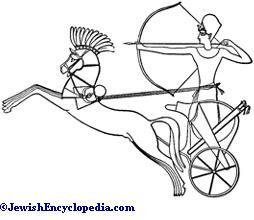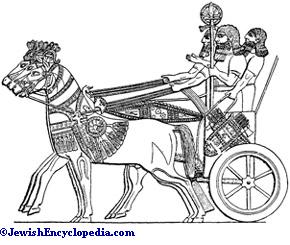CHARIOT:
(Redirected from CARRIAGE.)Vehicles are designated in Hebrew chiefly by two expressions, "'agalah" and "rakab," with "merkab" and "merkabah" derived from the latter. The former denotes the wagon used for heavy loads and general work, the name being connected with the root "to roll"; while the latter is the chariot of war or of state. Wagons for carrying burdens or persons are found among the different peoples of antiquity, having displaced at an early time the sledge and the drag on rollers, drawn by men or oxen (compare the pictures in Wilkinson, "Manners and Customs of the Ancient Egyptians," iii. 324). Early Egyptian monuments show also a frame like a litter, which was fastened between asses and used to carry persons.


Originally the wheels of the wagons were solid disks (ib. i. 369), but a more artistic type, consisting of hub, spokes, and fellies, was gradually evolved. The spokes, "ḥishshuḳim" (I Kings vii. 33), sprang from the hollow cylinder in the center of the wheel ("ofan" or "galgal"), that is, from the hub, "ḥishshurim" (I Kings vii. 33), around the stationary axletree, "yad," and connected it with the rim or the fellies, "gebim" (I Kings vii. 33; Ezek. i. 18, x. 12). In extant Assyrian illustrations the wheels generally have eight spokes, while in the Egyptian wagons four, or more frequently six, spokes are found. The body of the wagon and the pole were connected directly with the axletree. The pole had a yoke arranged for two animals only, so that each additional animal had to be harnessed separately, and not infront, but on the side of the first two animals. As horses did not come into general use among the Israelites until the time of Solomon, oxen were originally the chief draft animals (I Sam. vi. 7), while asses were generally used for the saddle. That the Israelites in very early times had wagons for carrying burdens, is evident from I Sam. vi. 7 and II Sam. vi. 3. Mention is also made of threshing-wagons (Isa. xxviii. 27). There is no definite information regarding harvesting-wagons (see Amos ii. 13). It is to be noticed that the latter are not used to-day in Palestine ("Zeit. Deutsch. Paläst. Ver." ix. 40, and the commentaries on Amos, l.c.). Persons traveled chiefly on asses, because the poor condition on the roads in Palestine made it difficult to use wagons to any extent, especially for long journeys. Nevertheless, the fact that the Egyptians evidently received the word  (Egyptian, "'agolt"), as well as
(Egyptian, "'agolt"), as well as  (Egyptian, "merkobt"), from the Canaanites, shows that wagon-building was known at an early date in Canaan.
(Egyptian, "merkobt"), from the Canaanites, shows that wagon-building was known at an early date in Canaan.
War-chariots proper were also known in Canaan at an early time, for as a result of having them the Canaanites were so superior to the Israelites that the latter could not meet them in open battle on the plain (Josh. xi. 4; Judges i. 19, iv. 3; I Sam. xiii. 5). These vehicles were indeed strange to the Israelites. Although David captured chariots and horses in his war with the Syrians, he did not use them, and even hamstrung the horses (II Sam. viii. 4). It remained for Solomon to introduce war-chariots, which were stationed partly in Jerusalem and partly in other cities (I Kings ix. 19). Beginning with his time, chariots and horsemen are often mentioned in the army of the southern as well as of the northern kingdom (I Kings xvi. 9; II Kings viii. 21, xiii. 7; Isa. ii. 7; Micah v. 9). Horses were indispensable to these chariots, and the great difficulty in procuring them (II Kings vii. 13, xviii. 23) probably often induced political leanings toward Egypt (Isa. xxx. 16, xxxi. 1, xxxvi. 9).
The war-chariots doubtless resembled the Assyrian and Egyptian two-wheeled chariots, open in the back; they were not furnished with scythes, as is often stated, for the latter were introduced by the Persians. They were made of fig-tree wood, and trimmed with bronze or iron. Like those of the Assyrians, the Hittites, and others, the chariots of the Israelites probably carried three men,  , the driver, the warrior proper, and the shield-bearer; while on those of the Egyptians there were generally but two men. According to I Kings x. 29 the price of a chariot imported from Egypt in the time of Solomon was 600 shekels, and that of a horse 150 shekels.
, the driver, the warrior proper, and the shield-bearer; while on those of the Egyptians there were generally but two men. According to I Kings x. 29 the price of a chariot imported from Egypt in the time of Solomon was 600 shekels, and that of a horse 150 shekels.
During the last decades of the southern kingdom mention is made of sun-horses and sun-chariots stationed in the outer court of the Temple, these being removed later by Josiah. They had been introduced at the time that syncretism was flourishing, and the cult of the sun-god had become dominant under Assyrian influence. As in the case of the Canaanite Baal (in reality the sun-god), the Assyro-Babylonian sun-god had been identified with


